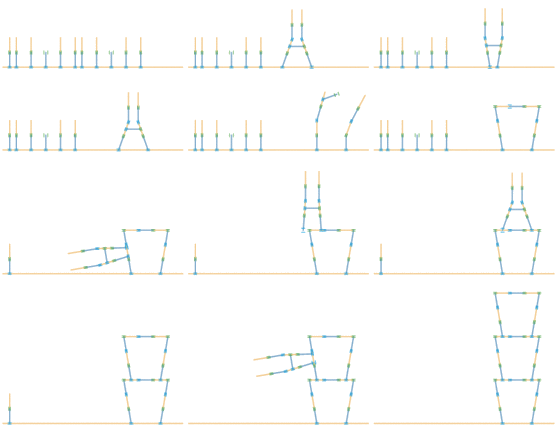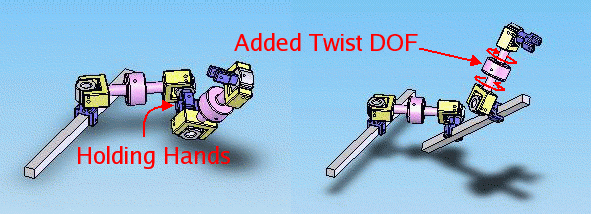MultiShady: A Bipartite Heterogeneous Unit Modular Self-Reconfigurable Robot
Carrick Detweiler, Alex Hornstein, Keith Kotay, Peter Osagie, Daniela
Rus, Paulina Varshavskaya, Iuliu Vasilescu,
Marsette A. Vona, Justin Werfel & Yeoreum Yoon
MultiShady
We are interested in self-assembly for truss structures, which has led us to investigate a new kind of self-reconfiguring robot system that is a generalization of our Shady window climbing robot [1]. MultiShady extends the Shady system to support an arbitrary number of cooperating Shady robots plus a set of passive bars (free "muntins" in the Shady model). The latter are simply unactuated rigid segments which are free to move under the power of one or more Shadys. Thus, MultiShady is a heterogeneous self-reconfigurable modular robot with two types of module (i.e. it is bipartite).
Research Context
Some other recently-proposed heterogeneous self-reconfiguring robots are also bipartite. The Molecule [2] has male and female modules. SOLAR [3] is a modular system composed of passive struts, which can be configured into 2D trusses by robots operating on an air hockey table. Self-assembling and self-reconfiguring truss systems can be a promising direction for robotic assembly of large structures in space (see, for example [4] for an overview of automatic structural assembly for NASA).
Simulation
We have begun development of a simulator for the MultiShady system, called MultiShadySim. Several stills from this simulator are shown below. Passive bars shown in gold, and the long horizontal bar is considered fixed in a world frame. Shadys (blue) have two distal rotating grippers that grab bars. The MultiShady system is a fully capable 2D self-reconfigurable robot: it can change topology (and hence, aggregate shape) without manual intervention, as this tower self-assembly sequence shows.

12 stills from a simulation of MultiShady self-assembling a tower.
While the MultiShady concept does not require any change to Shady's kinematic structure, it is unlikely that our current prototype single-Shady hardware (under development) will have the power to perform interesting MultiShady activity. In the future we may develop new hardware with such capability.
MultiShady is not the only possible formulation for multiple interacting Shady-like robots. Notably, though, this model does not require any modifications to the original Shady kinematic structure, at least for a planar implementation in which the segments and the links exist in (fixed) parallel planes.
MultiShady3D
We would also like to extend the Shady system to a full three-dimensional unit modular self-reconfigurable robot. This would allow Shady modules to move in 3D space and to make 3D truss structures.
While we were able to generalize the Shady robot into MultiShady (2D) without changing its kinematic topology, it seems unavoidable that in order to realize MultiShady3D, we will need to add degrees of freedom (DOF). To make design and control of the modules simple, it is preferable to keep the total number of DOF of each module as low as possible. Connected sets of several modules can be employed where more DOF are needed.
We are considering adding a single additional revolute DOF to Shady, a central twist capability as illustrated below, to achieve full 3D operation. An individual module will thus have three motive DOF: the twist and the gripper rotations. If we connect 2 modules hand-to-hand, the motive DOF of the pair increases to 5 (below left). And if we use a passive bar in addition to Shady robot modules, 6 motive DOF can be achieved, allowing arbitrary position and orientation in 3D space (below right).

Preliminary images of a concept for extending MultiShady to three dimensions by adding a twist DOF at the center of each Shady module.
References:
[1] Carrick Detweiler, Alex Hornstein, Keith Kotay, Peter Osagie, Daniela Rus, Paulina Varshavskaya, Iuliu Vasilescu, Marsette A. Vona, Justin Werfel, and Yeoreum Yoon. Shady: A Robotic Sunshade. In CSAIL Research Abstracts, 2005.
[2] Keith Kotay, Daniela Rus, Marsette Vona, and Craig McGray. The Self-reconfiguring Robotic Molecule. In Proceedings of IEEE International Conference on Robotics and Automation, 1998.
[3] Jacob Everist, Kasra Mogharei, Harshit Suri, Nadeesha Ranasinghe, Berok Khoshnevis, Peter Will, and Wei-Min Shen. A System for In-Space Assembly. In Proceedings of IEEE/RSJ International Conference on Intelligent Robots and Systems, 2004.
[4] William Doggert. Robotic Assembly of Truss Structures for Space Systems and Future Research Plans. In Proceedings of the IEEE Aerospace Conference, 2002.
The Stata Center, Building 32 - 32 Vassar Street - Cambridge, MA 02139 - USA tel:+1-617-253-0073 - publications@csail.mit.edu (Note: On July 1, 2003, the AI Lab and LCS merged to form CSAIL.) |
